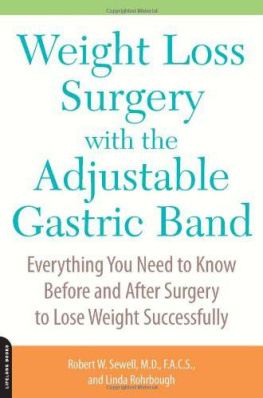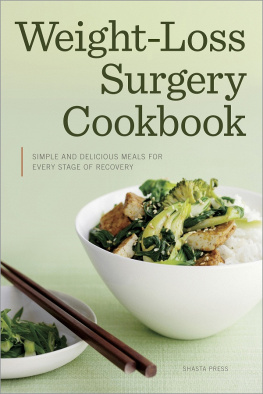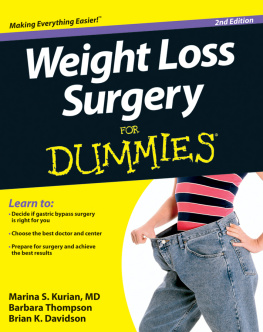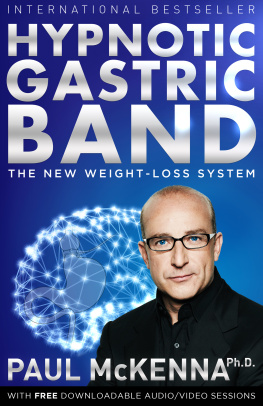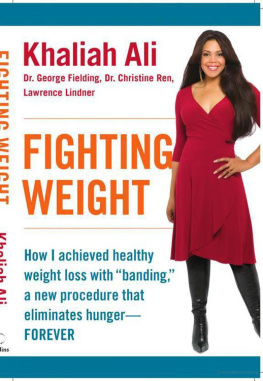ROBERT W. SEWELL, M.D., F.A.C.S., is an award-winning laparoscopic surgeon. His articles have been published in numerous medical journals and professional books, and he is a frequent speaker at medical conferences. Dr. Sewell has taught laparoscopic techniques all over the world, and he has over 300 AGB patients. He lives outside Dallas, Texas.
LINDA ROHRBOUGH is a best-selling author and patient of Dr. Sewell's. Rohrbough received a LAP-BAN' in early 2004 and has subsequently lost 136 pounds. She lives outside Dallas, Texas.
Robert W. Sewell, M.D., F.A.C.S.




Contents
ix
xi
SECTION 1
SECTION 2
SECTION 3
SECTION 4
11 The Health Benefits of the AGB and
SECTION 5
Preface
Dear Reader,
Any time you pick up a book that has anything to do with healthcare, there will invariably be some type of disclaimer. It seems that such things are necessary, even though it should be obvious to everyone that the material in any book is by its very nature meant for the general public, not as a specific recommendation for any individual. The following paragraph is our disclaimer.
The material contained in this book is intended solely for informational purposes. It is not a replacement for an individual consultation with your personal physician. It is not the intention here either to make a diagnosis or to recommend a specific treatment for any medical or psychological condition. In the event that any information contained in this book seems to conflict with the opinions or recommendations of your personal physician, you should rely on his or her judgment, since that is based on a personal knowledge and understanding of your specific situation. The opinions expressed in this book are those of the authors, or of those individuals quoted herein, and are based on their own personal experience. Other writers will undoubtedly offer conflicting opinions, which we encourage you to consider.
Now, with that out of the way, as you flip through this book, you'll notice right away that the majority of the photographs are not professionally done. They are not the best poses for the subjects; they are not airbrushed, nor are they altered in any way. In some cases, they are actually very amateurish. This is deliberate. We could have hired professional photographers to go out and make the individuals in these case studies look spectacular, especially in the "after" poses. Instead, we accepted the photos they offered us without any attempt to alter them. Most were taken by family members or nurses in a doctor's office.
We believe that showing you the "real" pictures allows you to clearly see the actual progress these band patients have made, but without any hype or exaggeration. You deserve to know what you're getting into, and to the best of our ability, we want to present you with the real picture-not something you'd see on a television commercial.
Most of our patients are thrilled with the adjustable gastric band, and for many it has led to spectacular results. But don't be fooled. There are trade-offs, lifestyle changes, and some cosmetic things that simply cannot be altered. That being said, it is our fondest desire that the personal stories and pictures contained in this book will offer you an element of hope, as they have for many others who have seen them.
Wishing you great losses,
Robert W Sewell, M.D., and Linda Rohrbough
Introduction
How We Got Here
When one life is changed, the world is changed.
-Thomas L. Johns
Robert W. Sewell, M.D.'s Story: Master Laparoscopic Surgeon
I have to admit, I didn't exactly embrace "the band" when I first heard about it. It sounded like just another gimmick procedure, and I had a legitimate surgical practice and a decent reputation I'd spent 23 years building.
To provide some context for my involvement in the adjustable gastric band (AGB) phenomenon, it is important to understand that as a general surgeon, I spend most of my time operating within the abdomen. As you might imagine, performing abdominal operations on an extremely obese patient is much more difficult than operating on a thin patient. Dealing with the unyielding nature of fat stored in and around the abdomen often made me feel as if I'd done an hour or more of isometric exercises. For that reason, and for many years, I would say to anyone who would listen, "I hate fat!" At the same time I was always quick to add that, if I had the medical "Midas touch" to cure one disease, it would not be heart disease, diabetes, or even cancer; it would be obesity. My rationale was that if obesity were eliminated, many of those other illnesses would become far less common and easier to treat. Besides, my job as a surgeon would be easier.
In December of 1989, I witnessed my first laparoscopic gallbladder operation, and my perspective on abdominal surgery changed forever. It became clear to me that virtually any surgical operation could be done using a laparoscopic approach, which makes use of a small camera to look into the cavity, allowing intra-abdominal procedures to be performed without the need for large incisions. Since that day I have vigorously pursued these minimally invasive techniques, and today my entire practice is limited to such procedures.
While the benefits of the minimally invasive approach for the patient were obvious, a side benefit for me also became apparent. Carbon dioxide gas used to inflate the abdomen during laparoscopic surgery holds the abdominal wall up, and does it without physical effort from me or my assistants. All of a sudden operating on obese patients was more or less the same as operating on anybody else no more "fighting the fat" just to get access to the inside of the abdomen.
Over the past 15 years, laparoscopic surgery has provided me with countless opportunities to be involved in a truly revolutionary process that is changing the entire field of general surgery. I have not only performed these new procedures but have been actively involved in training many of my colleagues in these innovative techniques. I've had the privilege of lecturing on this topic and supervising various laboratory sessions around the world. My motto was, If it's new ground-breaking technology, I want to be involved, both in performing and teaching the procedures except for bariatric surgery.
The surgical treatment of obesity was a very sore subject in most surgical circles during the 1970s, when I was in training. The procedures I was aware of were fraught with serious complications and were considered fringe medicine by the vast majority of surgeons. I avoided surgical treatment for obesity like the plague. Actually, I was taught very little about obesity, except that it was more a personal lifestyle choice than an actual illness. I was taught to believe that obese people needed a psychiatrist, not a surgeon. So when I was approached about doing laparoscopic gastric bypass in the mid-1990s, I replied without hesitation, "No way. I am not getting involved in that."

